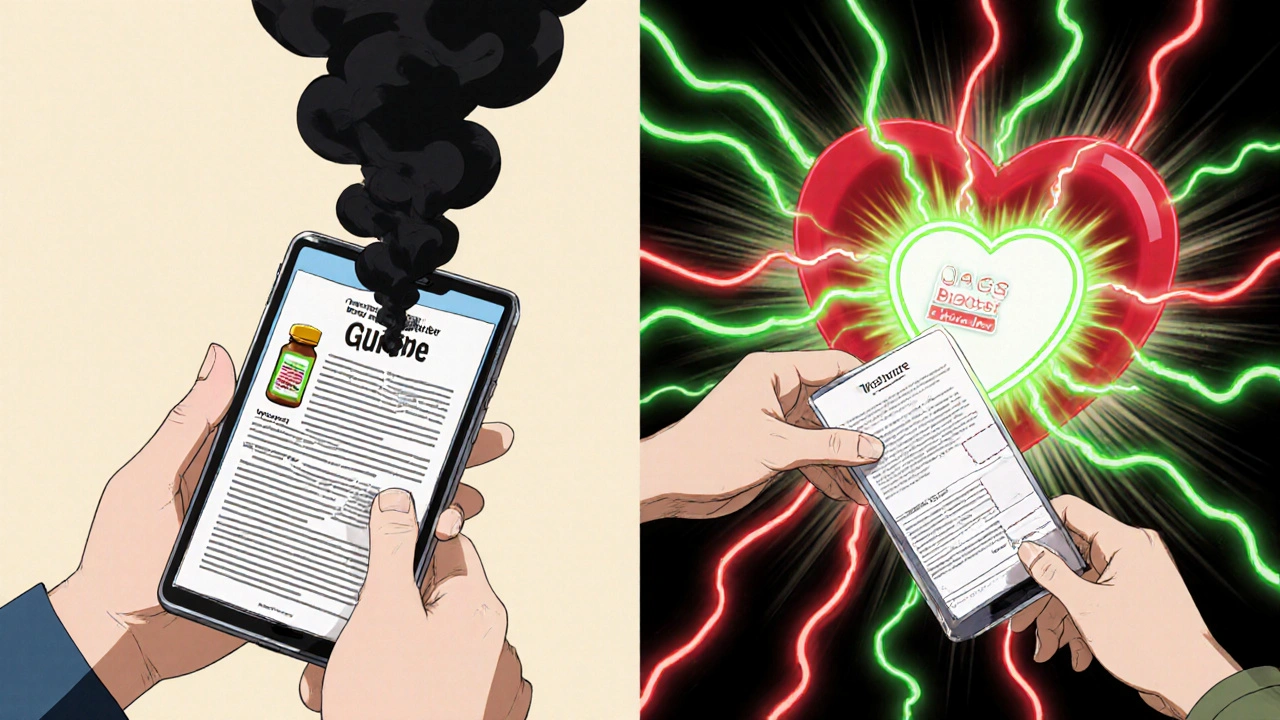When you pick up a new prescription, you’re handed a small paper-sometimes thin, sometimes folded-that’s called a Medication Guide. It’s not just a formality. This document is your lifeline for spotting serious risks and knowing exactly what to watch for. The FDA requires these guides for drugs with life-threatening side effects that can be avoided if you understand the warning. But most people skip them. And that’s dangerous.
Why Medication Guides Exist
Medication Guides aren’t marketing fluff. They’re legally required documents created by the FDA to protect you. Since 1997, the agency has forced drugmakers to write these guides in plain language when a medication carries serious, preventable dangers. Think liver failure, dangerous drops in blood cells, or sudden suicidal thoughts. These aren’t rare side effects-they’re real, measurable risks that happen to real people every day. Right now, there are about 150 active Medication Guides in the U.S., covering everything from antidepressants to blood thinners to cancer drugs. Each one is updated within 30 days if new safety data comes out. That means even if you’ve read your guide before, it might have changed. And if you’re still using the same one from last year, you could be missing critical updates.The Seven Sections You Must Read
Every Medication Guide follows the same structure. Don’t skip ahead. Start at the top and work your way down. Here’s what each section means-and what you need to do:- What is the most important information I should know? This is the heart of the guide. It’s where the FDA forces drugmakers to spell out the worst risks in plain terms. Look for phrases like “can cause serious liver damage” or “may lead to life-threatening infections.” This isn’t vague. It’s specific. If it says “can cause,” it means it has happened-and it can happen to you.
- What should I tell my healthcare provider before taking this? This tells you who shouldn’t take the drug. Are you pregnant? Do you have liver disease? Have you had a stroke? This section lists conditions that make the drug unsafe for you. If you check “yes” to any of these, talk to your doctor before swallowing the first pill.
- What are the possible or reasonably likely serious side effects? This is where monitoring instructions live. You’ll find phrases like “get your blood tested regularly” or “call your doctor immediately if you notice.” These aren’t suggestions. They’re orders. For example, the guide for the psoriasis drug deucravacitinib says you need a blood test before starting and every 3 months after. If you skip those tests, you’re flying blind.
- How should I take this? This section ties the risk to your schedule. It tells you when to get tests, how often, and what to do if your dose changes. The blood thinner warfarin guide says: “If your dose is changed, your INR should be checked more often.” That’s not optional. That’s your safety net.
- What should I avoid while taking this? Alcohol, sunlight, driving, certain foods-these are all red flags. The antidepressant guides say: “Do not drink alcohol.” The cancer drug abiraterone says: “Avoid grapefruit.” These aren’t casual warnings. They’re direct links to increased risk.
- What are the common side effects? This is the “mild stuff”-headache, nausea, dizziness. It’s not the focus. Don’t get distracted here. Your real concern is the serious side effects section.
- How should I store this? This is the least important. Skip it unless you’re traveling or living in extreme heat or humidity.
How to Spot Monitoring Triggers
The biggest mistake people make? They think “monitor” means “wait until you feel something.” That’s wrong. Monitoring means testing before you feel anything. Here are the seven phrases that signal a red flag:- “Get blood tests regularly”
- “Call your doctor immediately if”
- “Do not stop taking without talking to your doctor”
- “Avoid sunlight exposure”
- “Do not drink alcohol”
- “May impair driving ability”
- “Keep all scheduled appointments”
Real-World Examples That Save Lives
Take antidepressants. Every SSRI and SNRI guide says the same thing: “Pay close attention to any changes, especially sudden changes, in mood, behavior, thoughts, or feelings.” This isn’t a generic warning. It’s based on data showing suicide risk spikes in the first 4-6 weeks of treatment. If you’re starting an antidepressant, tell someone close to you: “Watch me. If I seem withdrawn, angry, or talk about not wanting to live, call my doctor right away.” Or look at warfarin. The guide says: “Your INR should be checked at least monthly. If your dose changes, check it more often.” INR is a blood test that measures how fast your blood clots. Too high? You could bleed internally. Too low? You could have a stroke. The guide doesn’t say “maybe check.” It says “must check.” And if you don’t? Your risk of a major bleed goes up by 300%. Even cancer drugs like abiraterone (Zytiga) have clear instructions: “Your healthcare provider should perform blood tests before you start and every 3 months while taking this medicine.” These aren’t suggestions. They’re non-negotiable. Skip them, and you risk liver failure.How to Make the Guide Work for You
Most people read the guide once and forget it. That’s not enough. Use this simple system:- 3-2-1 Rule: Spend 3 minutes reading the guide before your first dose. Spend 2 minutes reviewing it before each refill. Spend 1 minute checking for updates during treatment.
- Color Code: Use a highlighter. Yellow for “test,” “monitor,” “check.” Red for “call your doctor immediately.” Green for “common side effects” (you can ignore these).
- Create a Calendar: Write down your blood test dates on your phone calendar. Set reminders 2 days before. If your guide says “every 3 months,” mark it for the same day each quarter.
- Keep a Journal: Record your test results, symptoms, and doses. A University of Michigan study found patients who did this had 68% fewer adverse events.
- Ask Your Pharmacist: When you pick up your script, say: “Can you point out the monitoring part of the guide?” Pharmacists say that when they do this, compliance with blood tests jumps from 45% to 82%.

What If You Don’t Get the Guide?
By law, the pharmacy must give you a Medication Guide every time you fill a prescription that requires one. If they don’t, ask for it. If they say, “We don’t have it,” call the manufacturer’s customer service number listed on the bottle. Or go to DailyMed (dailymed.nlm.nih.gov), the NIH’s official database. You can search by drug name and download the latest version. In 2022, over 12 million people did this.What’s Changing Soon
The FDA is pushing for better guides. By 2026, all high-risk drugs will have QR codes on the packaging that link directly to the latest guide. Some companies are already testing AI tools that personalize the guide based on your age, health history, and other meds you take. Pfizer’s pilot program showed patients understood their risks 63% better when the guide focused only on what applied to them. But here’s the hard truth: Even with better design, 40% of Americans still won’t understand these guides. Why? Because they weren’t taught how to read them. That’s on you. You don’t need a medical degree. You just need to slow down, look for the red flags, and act.What to Do Next
Right now, find your most recent prescription. Pull out the Medication Guide. Open it to the first page. Read the “Most Important Information” section. Then go to the “Serious Side Effects” section. Find the word “test” or “monitor.” Circle the frequency. Write it down. Set a reminder. Do this today. Not tomorrow. Today. Your life might depend on it.Are Medication Guides the same as the package insert?
No. The package insert is for doctors and pharmacists-it’s long, technical, and full of jargon. The Medication Guide is for you. It’s written in plain language, follows strict FDA formatting rules, and only exists for drugs with serious, preventable risks. You should always read the Medication Guide, not the insert.
Can I rely on my doctor to explain all the risks?
Not always. Doctors are busy. Many prescribe 20-30 drugs a day. They may not remember every risk for every medication. The Medication Guide is your backup. It’s the only document legally required to be given to you with exact, up-to-date safety info. Don’t assume your doctor told you everything. Read the guide yourself.
What if I don’t understand a word in the guide?
Look it up. Use a simple search engine like Google. Type the word + “definition” (e.g., “INR definition”). Or ask your pharmacist. They’re trained to explain these guides. Don’t pretend you understand. Misunderstanding “weekly” as “when I feel sick” could be deadly.
Why do some guides have numbers like “1 in 200” while others say “may cause”?
The FDA encourages specific numbers because they’re clearer. “1 in 200” tells you the exact risk. “May cause” is vague and easy to ignore. If a guide gives you a number, treat it as real. If it doesn’t, assume the risk is still serious-just harder to measure. Don’t downplay a risk just because it’s not quantified.
Do I need to read the guide every time I refill?
Yes. Drugmakers update guides when new safety data comes out. In 2022, 92% of guides were updated. Your guide from last year might be outdated. Even if your dose hasn’t changed, the risk profile might have. Always review before each refill.
What if I miss a blood test or monitoring appointment?
Call your doctor immediately. Don’t wait. Some risks, like low white blood cell counts or liver damage, build silently. Missing one test doesn’t mean disaster-but it means you’re no longer protected. Your doctor may need to pause your medication until you get tested. Better safe than sorry.
Can I share my Medication Guide with someone else?
No. Medication Guides are specific to the drug and your prescription. What’s safe for you might be deadly for someone else. Never give your guide to another person, even if they take the same drug. Their dose, health history, and risks could be completely different.
Are Medication Guides available in other languages?
Some are. The FDA requires manufacturers to provide guides in Spanish if a significant portion of users speak it. Other languages vary by drug and company. Check DailyMed or ask your pharmacist. If you need a translation, don’t rely on Google Translate. Ask your pharmacy if they have a certified version.







Tom Shepherd
November 28, 2025 AT 01:08Just read my warfarin guide for the first time after 3 years. Turns out I’ve been skipping my monthly INR checks because I ‘felt fine.’ Whoops. Set a reminder now. Don’t be like me.
Jauregui Goudy
November 28, 2025 AT 04:37THIS. RIGHT HERE. I used to toss these guides in the trash like junk mail. Then my cousin went into liver failure on a drug she didn’t even know was risky. She’s fine now-but barely. Read the damn guide. It’s not fluff. It’s your lifeline. Highlight it. Print it. Tape it to your mirror. Do it now.
Rhiana Grob
November 28, 2025 AT 20:05I appreciate how clearly this breaks down the structure. Many patients don’t realize these guides are legally mandated and updated regularly. I work in patient advocacy, and I’ve seen too many adverse events that could’ve been prevented with just 5 minutes of reading. I encourage everyone to treat this like a safety briefing before boarding a plane.
Frances Melendez
November 29, 2025 AT 08:10Of course you’re supposed to read these. But let’s be real-how many people actually do? The system is designed to make you feel guilty for not reading 12 pages of tiny text while your doctor rushes you out the door. This post is performative concern. Real change would be better training for providers, not shaming patients.
Sue Haskett
November 29, 2025 AT 10:39I love that you included the color-coding tip! I started doing this with my mom’s meds-yellow for blood tests, red for ‘call immediately,’ green for ‘mild stuff.’ She’s 72, has three prescriptions, and now she checks her calendar every Sunday. We even made a little chart. It’s small, but it’s helping. Thank you for making it feel doable.
Jonah Thunderbolt
November 30, 2025 AT 21:23QR codes? AI personalization? Cute. But the FDA still lets pharma write these guides. You think Pfizer’s gonna make a guide that says, ‘This drug causes 4x more strokes in people over 65’? Nah. They’ll bury it in ‘may cause’ language and slap a QR code on it. This is PR, not safety. Trust nothing. Always cross-check with DailyMed.
Lauren Zableckis
December 2, 2025 AT 00:10I’ve been a pharmacist for 18 years. I’ve watched people ignore these guides, then blame the doctor when something goes wrong. But I’ve also seen the opposite: patients who read them, ask smart questions, and live longer. It’s not about being smart-it’s about being willing to pause. Just pause. Read one section. That’s all it takes.
Gayle Jenkins
December 2, 2025 AT 03:11Do you know what’s worse than not reading the guide? Thinking you’ve read it. I had a patient who said, ‘I read it-everything looked fine.’ I asked her what ‘agranulocytosis’ meant. She said, ‘Something with your gums?’ Nope. It’s a deadly drop in white blood cells. You don’t need a degree-but you do need to look up words. Google is your friend. Don’t guess.
Allison Turner
December 3, 2025 AT 16:28So… you’re saying we’re supposed to read all this? And remember it? And set reminders? And color code? And check DailyMed? Wow. So much work. Maybe the real problem is that we’re expected to be medical experts just to stay alive. This feels like victim-blaming wrapped in a highlighter.
Darrel Smith
December 5, 2025 AT 00:20Look I’ve been on 17 different meds in the last decade and I read every guide and I’ve never had a problem but I know people who died because they didn’t and I’m telling you right now if you don’t read these you are asking for trouble and your doctor is not going to save you because they are overworked and underpaid and honestly they don’t care as much as you think they do and if you don’t take responsibility for your own body then you deserve what happens to you and I’m not being mean I’m being real
Aishwarya Sivaraj
December 6, 2025 AT 06:27Interesting post but I wonder if the real issue is accessibility. Many elderly or low-literacy patients get these guides in English even if their first language is Spanish or Hindi. And even if they read English, medical terms like 'INR' or 'agranulocytosis' are not everyday words. Maybe the solution is not just reading but community health workers who explain it in local languages and simple terms. I saw this work in rural India-people listened when a neighbor explained it, not a pamphlet
Iives Perl
December 7, 2025 AT 07:00They’re tracking you through these guides. QR codes? AI personalization? That’s not safety-that’s data harvesting. Your health info is being sold. They want you to read it so they can profile you. Next thing you know, your insurance rates go up because you ‘failed to comply’ with a guide you didn’t even ask for. Don’t be fooled.